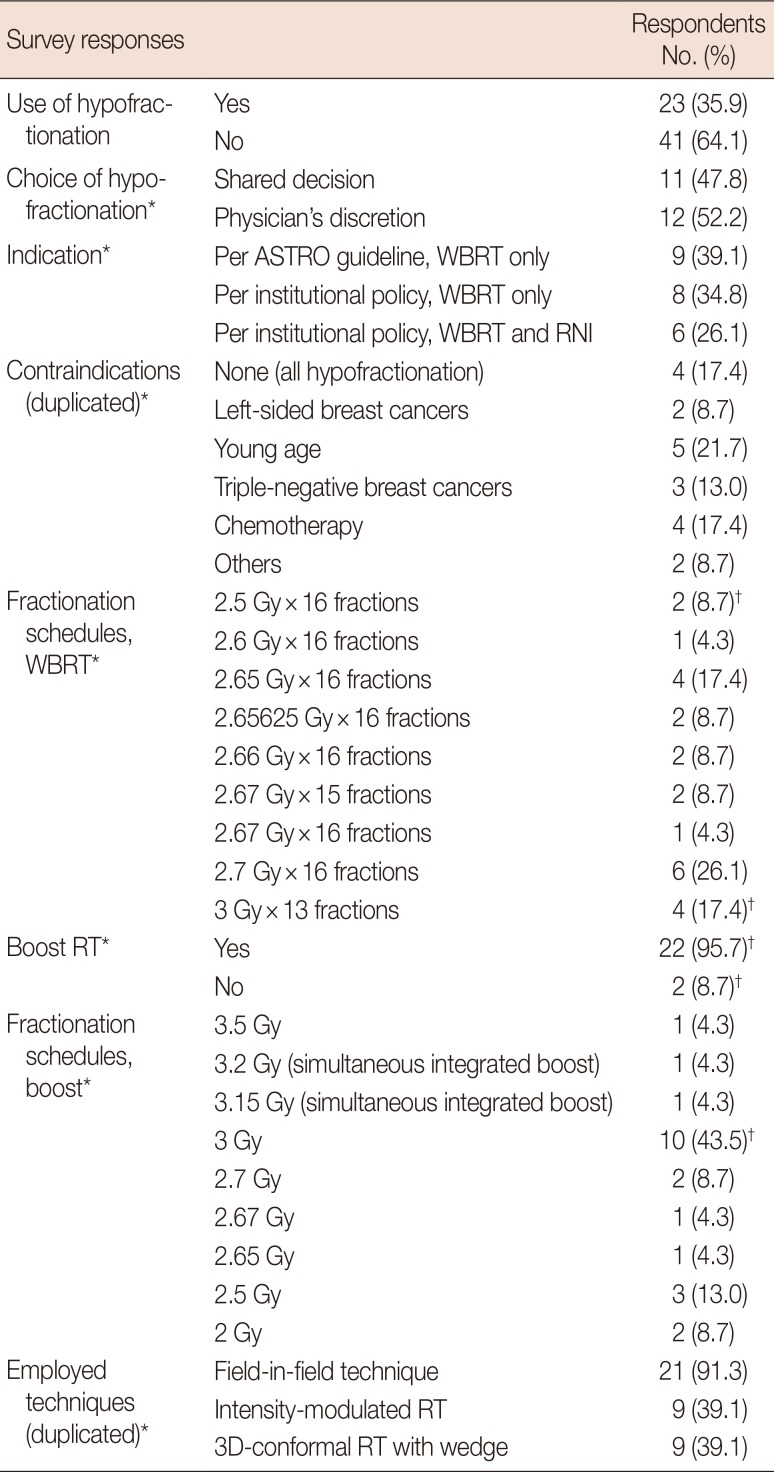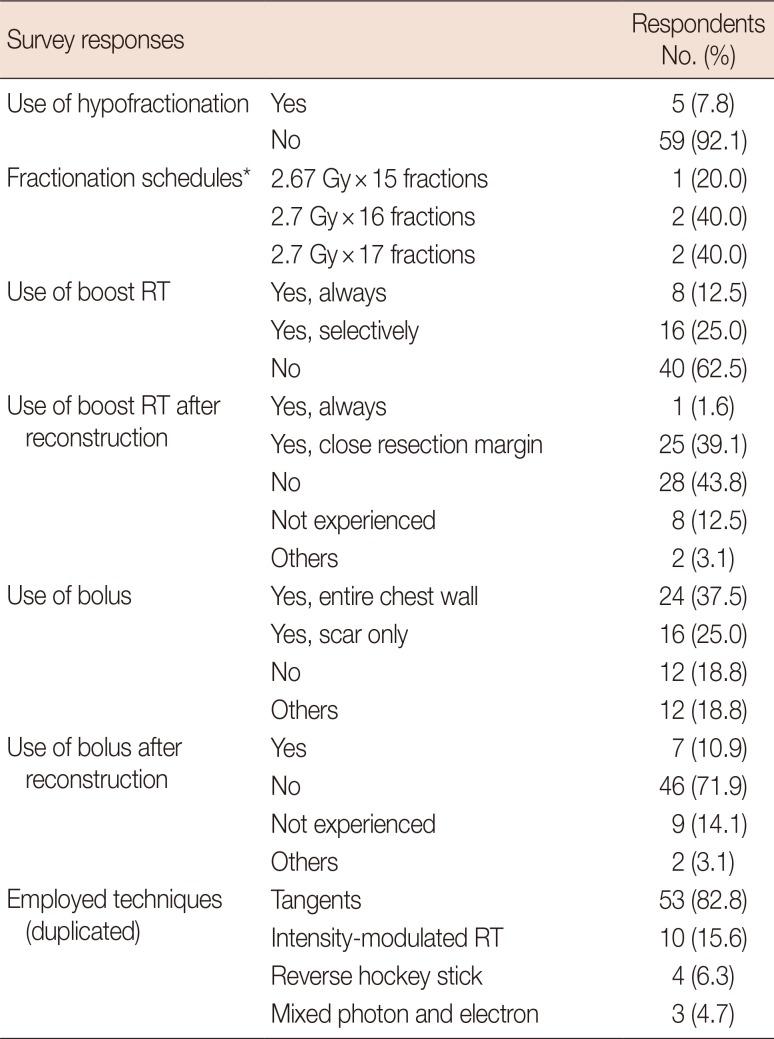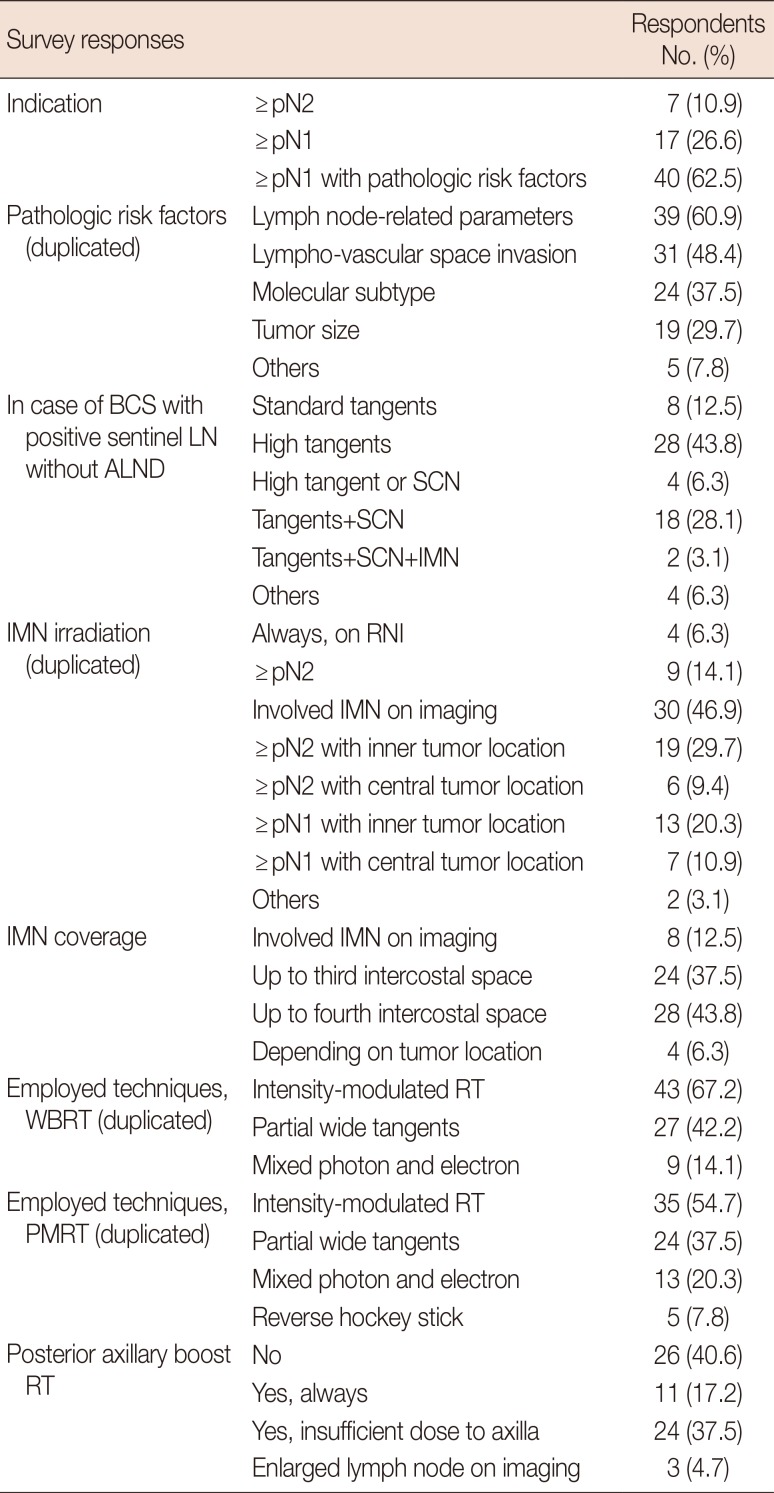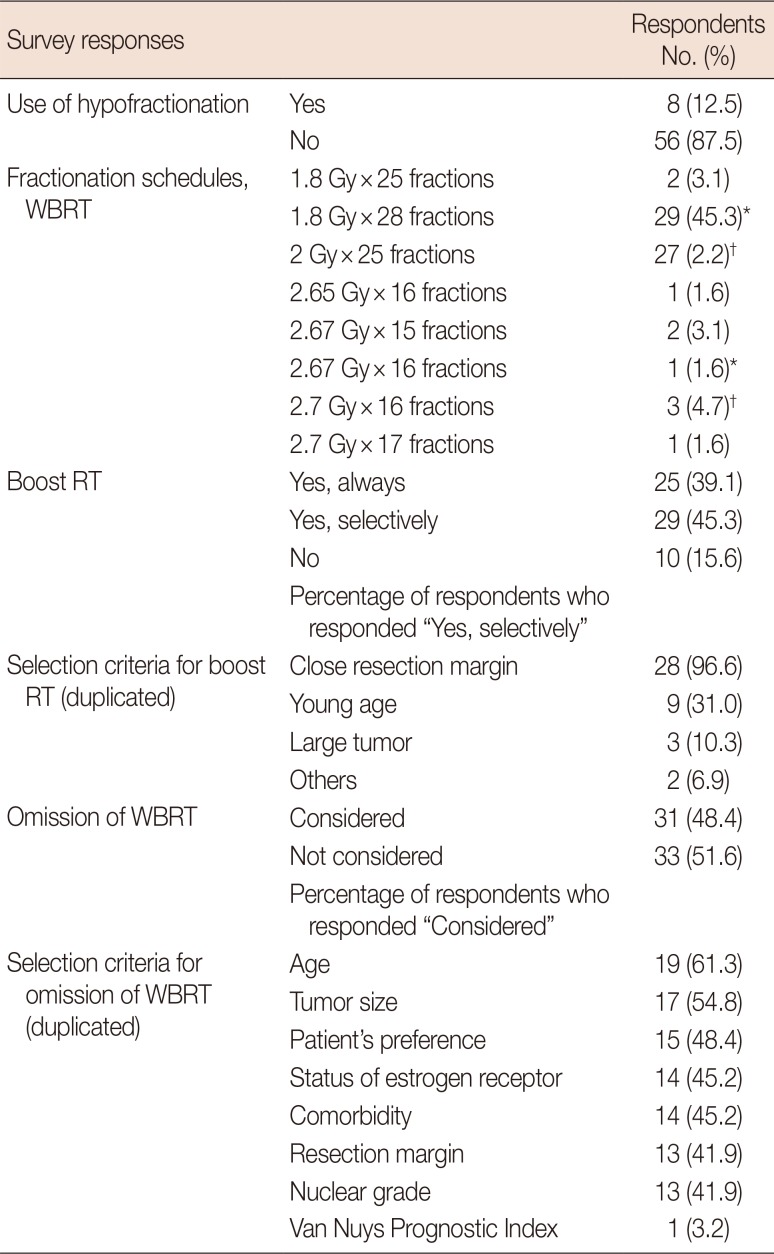1. Jung KW, Won YJ, Kong HJ, Lee ES. Community of Population-Based Regional Cancer Registries. Cancer statistics in Korea: incidence, mortality, survival, and prevalence in 2015. Cancer Res Treat. 2018; 50:303–316. PMID:
29566481.

2. Van de Steene J, Soete G, Storme G. Adjuvant radiotherapy for breast cancer significantly improves overall survival: the missing link. Radiother Oncol. 2000; 55:263–272. PMID:
10869741.

3. Veronesi U, Luini A, Del Vecchio M, Greco M, Galimberti V, Merson M, et al. Radiotherapy after breast-preserving surgery in women with localized cancer of the breast. N Engl J Med. 1993; 328:1587–1591. PMID:
8387637.

4. Ceilley E, Jagsi R, Goldberg S, Grignon L, Kachnic L, Powell S, et al. Radiotherapy for invasive breast cancer in North America and Europe: results of a survey. Int J Radiat Oncol Biol Phys. 2005; 61:365–373. PMID:
15667954.

5. Nguyen K, Mackenzie P, Allen A, Dreosti M, Morgia M, Zissiadis Y, et al. Breast interest group faculty of radiation oncology: Australian and New Zealand patterns of practice survey on breast radiotherapy. J Med Imaging Radiat Oncol. 2017; 61:508–516. PMID:
27987274.

6. Delaney GP, Gandhidasan S, Walton R, Terlich F, Baker D, Currow D. The pattern of use of hypofractionated radiation therapy for early-stage breast cancer in New South Wales, Australia, 2008 to 2012. Int J Radiat Oncol Biol Phys. 2016; 96:266–272. PMID:
27473814.

7. Algara M, Arenas M, De Las Peñas Eloisa Bayo D, Muñoz J, Carceller JA, Salinas J, et al. Radiation techniques used in patients with breast cancer: results of a survey in Spain. Rep Pract Oncol Radiother. 2012; 17:122–128. PMID:
24377012.

8. van der Laan HP, Hurkmans CW, Kuten A, Westenberg HA. EORTC-ROG Breast Working Party. Current technological clinical practice in breast radiotherapy: results of a survey in EORTC-Radiation Oncology Group affiliated institutions. Radiother Oncol. 2010; 94:280–285. PMID:
20116120.

9. Hui Z, Li Y, Yu Z, Liao Z. Survey on use of postmastectomy radiotherapy for breast cancer in China. Int J Radiat Oncol Biol Phys. 2006; 66:1135–1142. PMID:
16979834.

10. Keum KC, Shim SJ, Lee IJ, Park W, Lee SW, Shin HS, et al. The 1998, 1999 patterns of care study for breast irradiation after mastectomy in Korea. J Korean Soc Ther Radiol Oncol. 2007; 25:7–15.
11. Kang JK, Kim MS, Jang WI, Seo YS, Kim HJ, Cho CK, et al. The clinical utilization of radiation therapy in Korea between 2009 and 2013. Radiat Oncol J. 2016; 34:88–95. PMID:
27381419.

12. Cox JD, Stetz J, Pajak TF. Toxicity criteria of the Radiation Therapy Oncology Group (RTOG) and the European Organization for Research and Treatment of Cancer (EORTC). Int J Radiat Oncol Biol Phys. 1995; 31:1341–1346. PMID:
7713792.

13. Delaney G, Blakey D, Drummond R, Kenny L, Centre RO. Breast radiotherapy: an Australasian survey of current treatment techniques. Australas Radiol. 2001; 45:170–178. PMID:
11380359.

14. Ciervide R, Dhage S, Guth A, Shapiro RL, Axelrod DM, Roses DF, et al. Five year outcome of 145 patients with ductal carcinoma in situ (DCIS) after accelerated breast radiotherapy. Int J Radiat Oncol Biol Phys. 2012; 83:e159–e164. PMID:
22579378.

15. Lalani N, Paszat L, Sutradhar R, Thiruchelvam D, Nofech-Mozes S, Hanna W, et al. Long-term outcomes of hypofractionation versus conventional radiation therapy after breast-conserving surgery for ductal carcinoma in situ of the breast. Int J Radiat Oncol Biol Phys. 2014; 90:1017–1024. PMID:
25220719.

16. Koukourakis MI, Panteliadou M, Abatzoglou IM, Sismanidou K, Sivridis E, Giatromanolaki A. Postmastectomy hypofractionated and accelerated radiation therapy with (and without) subcutaneous amifostine cytoprotection. Int J Radiat Oncol Biol Phys. 2013; 85:e7–e13. PMID:
23040218.

17. Ali EM, Abd AlMageed MK. Post-mastectomy hypofractionation radiotherapy in breast cancer patients. Cancer Oncol Res. 2014; 2:87–93.
18. START Trialists' Group. Bentzen SM, Agrawal RK, Aird EG, Barrett JM, Barrett-Lee PJ, et al. The UK Standardisation of Breast Radiotherapy (START) Trial B of radiotherapy hypofractionation for treatment of early breast cancer: a randomised trial. Lancet. 2008; 371:1098–1107. PMID:
18355913.
19. Whelan T, MacKenzie R, Julian J, Levine M, Shelley W, Grimard L, et al. Randomized trial of breast irradiation schedules after lumpectomy for women with lymph node-negative breast cancer. J Natl Cancer Inst. 2002; 94:1143–1150. PMID:
12165639.

20. Suh WW, Pierce LJ, Vicini FA, Hayman JA. A cost comparison analysis of partial versus whole-breast irradiation after breast-conserving surgery for early-stage breast cancer. Int J Radiat Oncol Biol Phys. 2005; 62:790–796. PMID:
15936561.

21. Smith BD, Bentzen SM, Correa CR, Hahn CA, Hardenbergh PH, Ibbott GS, et al. Fractionation for whole breast irradiation: an American Society for Radiation Oncology (ASTRO) evidence-based guideline. Int J Radiat Oncol Biol Phys. 2011; 81:59–68. PMID:
20638191.

22. Smith BD, Bellon JR, Blitzblau R, Freedman G, Haffty B, Hahn C, et al. Radiation therapy for the whole breast: executive summary of an American Society for Radiation Oncology (ASTRO) evidence-based guideline. Pract Radiat Oncol. 2018; 8:145–152. PMID:
29545124.

23. Whelan TJ, Olivotto IA, Parulekar WR, Ackerman I, Chua BH, Nabid A, et al. Regional nodal irradiation in early-stage breast cancer. N Engl J Med. 2015; 373:307–316. PMID:
26200977.

24. EBCTCG (Early Breast Cancer Trialists' Collaborative Group). McGale P, Taylor C, Correa C, Cutter D, Duane F, et al. Effect of radiotherapy after mastectomy and axillary surgery on 10-year recurrence and 20-year breast cancer mortality: meta-analysis of individual patient data for 8135 women in 22 randomised trials. Lancet. 2014; 383:2127–2135. PMID:
24656685.
25. Giuliano AE, Hunt KK, Ballman KV, Beitsch PD, Whitworth PW, Blumencranz PW, et al. Axillary dissection vs no axillary dissection in women with invasive breast cancer and sentinel node metastasis: a randomized clinical trial. JAMA. 2011; 305:569–575. PMID:
21304082.
26. Worni M, Akushevich I, Greenup R, Sarma D, Ryser MD, Myers ER, et al. Trends in treatment patterns and outcomes for ductal carcinoma in situ. J Natl Cancer Inst. 2015; 107:djv263. PMID:
26424776.

27. Narod SA, Iqbal J, Giannakeas V, Sopik V, Sun P. Breast cancer mortality after a diagnosis of ductal carcinoma in situ. JAMA Oncol. 2015; 1:888–896. PMID:
26291673.

28. Solin LJ, Gray R, Hughes LL, Wood WC, Lowen MA, Badve SS, et al. Surgical excision without radiation for ductal carcinoma in situ of the breast: 12-year results from the ECOG-ACRIN E5194 Study. J Clin Oncol. 2015; 33:3938–3944. PMID:
26371148.

29. McCormick B, Winter K, Hudis C, Kuerer HM, Rakovitch E, Smith BL, et al. RTOG 9804: a prospective randomized trial for good-risk ductal carcinoma in situ comparing radiotherapy with observation. J Clin Oncol. 2015; 33:709–715. PMID:
25605856.

30. Shumway DA, McLeod CM, Morrow M, Li Y, Kurian AW, Sabolch A, et al. Patient experiences and clinician views on the role of radiation therapy for ductal carcinoma in situ. Int J Radiat Oncol Biol Phys. 2018; 100:1237–1245. PMID:
29439886.









 PDF
PDF ePub
ePub Citation
Citation Print
Print



 XML Download
XML Download